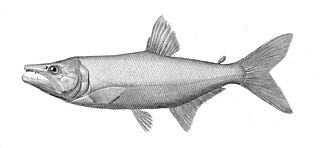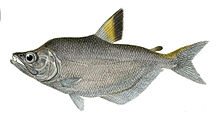
The Poeciliidae are a family of freshwater fishes of the order Cyprinodontiformes, the tooth-carps, and include well-known live-bearing aquarium fish, such as the guppy, molly, platy, and swordtail. The original distribution of the family was the Southeastern United States to north of Río de la Plata, Argentina, and Africa, including Madagascar. Due to release of aquarium specimens and the widespread use of species of the genera Poecilia and Gambusia for mosquito control, though, poeciliids can today be found in all tropical and subtropical areas of the world. In addition, Poecilia and Gambusia specimens have been identified in hot springs pools as far north as Banff, Alberta.

Ancistrus is a genus of nocturnal freshwater fish in the family Loricariidae of order Siluriformes, native to freshwater habitats in South America and Panama. Fish of this genus are common in the aquarium trade where they are known as bushynose or bristlenose catfish. In the aquarium hobby they are often referred to as bushynose or bristlenose plecos instead, but this may lead to confusion as "pleco" usually is used for Hypostomus plecostomus and its allies and is often used as a catchall term for any loricariids remotely resembling that species.

Acestrorhynchus is a genus of 14 species of characiform fish found only in fresh water in South America, the sole genus in the family Acestrorhynchidae. Their greatest diversity is in the Orinoco and Amazon basins.

Hyphessobrycon is a genus of freshwater fish in the family Characidae. These species are among the fishes known as tetras. The genus is distributed in the Neotropical realm from southern Mexico to Río de la Plata in Argentina. Many of these species are native to South America; about six species are from Central America and a single species, H. compressus is from southern Mexico.

Astyanax is a genus of freshwater fish in the family Characidae of the order Characiformes. Some of these fish, like many of their relatives, are kept as aquarium pets and known collectively as tetras. With around 150 described species and new ones being described yearly, this genus is among the largest of the entire order; Hyphessobrycon also has more than 145 species and which one is larger at any one time depends on whether more species have been recently described in one or the other. The blind and colorless cave tetra of Mexico is a famous member of the genus, but its taxonomic position is disputed: Some recognize it as part of the Mexican tetra and this is supported by phylogenetic evidence, but others recognize the cave form as a separate species, A. jordani.

Leporinus is a genus of fish in the family Anostomidae native to South America. The fossil species Leporinus scalabrinii, known from the late Miocene of Entre Ríos in Argentina, has only recently been added to this genus after being misidentified as a species of primate under the name Arrhinolemur scalabrinii for over 100 years.
Cordylancistrus is a genus of suckermouth armored catfish native to South America. It is much the same as Chaetostoma. The few differences are a wider head, longer cheek odontodes, and plates on the snout. Cordylancistrus can be found in rivers and streams high in the Andes, from Venezuela to Colombia.

Charax is a genus containing several species of South American tetras, including the glass headstander, C. gibbosus. These fish, among other characteristics, are small and have a rhomboid shape. Some species are semi-translucent.

Astroblepus is a genus of fish in the family Astroblepidae found in South America and Panama. This genus is the only member of its family. These catfishes are primarily found in torrential streams in the Andean area. Astroblepus pholeter and A. riberae are troglobites adapted to living in subterranean water systems. These species are typically small, less than 10 cm (4 in). The largest species reaches 30 cm (1 ft). These fish have suckermouths like those of loricariids. They have two pairs of barbels, maxillary and nasal. The dorsal fin spine lacks a locking mechanism. These fish also have odontodes, tiny teeth on their skin. All species exhibit a conical, pointy type on their fin rays like that found in other loricarioids; other species also exhibit a blunt type that is only found on their skin.

Glandulocaudinae are a subfamily of tropical freshwater characin fish from Central and South America. In all species of this subfamily, a gland on their caudal fin is found almost exclusively in the males, which allows the release and pumping of pheromones; also, members of this subfamily have complex courtship behaviors which lead to insemination. The ecology and life history of these fish is complex yet little studied. Glandulocaudines are important as food fish for larger fish important for commercial and subsistence reasons.

Pimelodus is a genus of fish in the family Pimelodidae native to Central and South America.

Pimelodella is a genus of three-barbeled catfishes.
Cetopsorhamdia is a genus of three-barbeled catfishes native to South America.

Chaetostoma, also known as the bristlemouth catfish, is a genus of suckermouth armored catfishes native to South America with one species, C. fischeri, extending into Panama. Most species inhabit flowing rivers in the lower Andes and its foothills. Some species are kept in unheated aquaria.

Moenkhausia is a genus of freshwater fish in the family Characidae native to tropical and subtropical South America. These are medium-sized tetras where the largest species only reach around 12 cm (4.7 in).
Knodus is a genus of characins, small freshwater fish from South America.
Monotocheirodon is a genus of characins native to tropical South America. The currently recognized species in this genus are:
Saccoderma is a genus of characins found in Colombia and Venezuela. The three currently described species in this genus are:
Nemuroglanis is a genus of three-barbeled catfishes. With the exception of N. panamensis from Panama, they are native to tropical South America.
Dolichancistrus is a genus of suckermouth armored catfishes native to South America.













